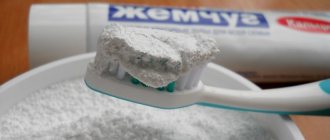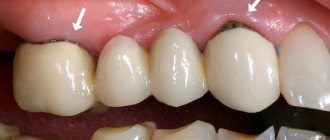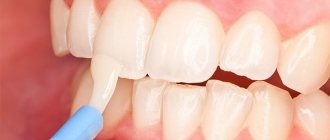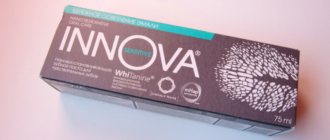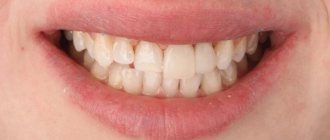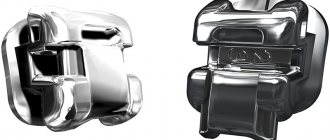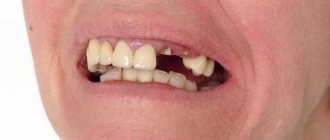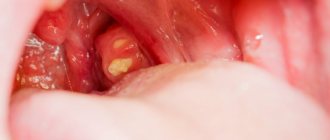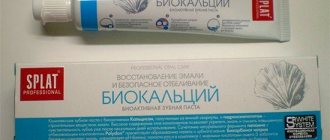What is a sandwich prosthesis?
We are talking about the development of Russian doctors, which, judging by the reviews of dentists and patients, is no worse than its European counterparts. “Sandwiches” are dentures made of dense polymer that imitates the shape of the jaw arch and covers the gums. The sandwich denture is fixed onto natural teeth, while the palate remains free, and the structure itself fits very tightly. The latter is provided by a substrate made of soft hypoallergenic material, which changes properties, adapting to changes occurring in the mouth. A distinctive feature of a sandwich prosthesis is the presence of rigid fasteners. The design, in comparison with classic clasps, stays more securely in the oral cavity and does not require the use of special fixing compounds.
History of creation
Sandwich dentures were developed in Russia by a group of dental specialists from the Persona-Life clinic based on advanced modern technical solutions.
The name is derived from the features that combine several materials with different physical properties. This makes it possible to solve a wide range of problems characteristic of traditional overlay prostheses.
Such a prosthesis does not require the use of fixing paste and provides the best fit to the mucosa.
What does a Sandwich denture look like?
This is a development of Russian dentists, which in terms of characteristics and patient reviews is in no way inferior to numerous European analogues. A sandwich prosthesis made of dense polymer completely follows the shape of the dental arch and covers the patient’s gums.
The removable structure is tightly fixed on the teeth and does not affect or irritate the palate. The backing of the prosthesis is made of elastic material, deformable, and adapts to any jaw shape.
Essentially, these are removable teeth that fill gaps in the dentition and are secured with rigid clasps. Such metal devices are fixed to the teeth remaining in the mouth, implanted implants or pulpless roots. The clasps are securely attached and prolong the wearing of the removable structure.
If the mouth is missing several adjacent teeth at once, the patient is fitted with a sandwich dental bridge, which fills the large gaps in the jaw. Indistinguishable from natural teeth.
Design Features
The “sandwich” is a dental invention without the disadvantages of conventional overdentures. Thanks to a frame made of high-strength materials, it is attached to the remaining teeth and leaves the hard palate free , while ensuring firmness and a tight fit.
The latter is achieved through the use of a substrate made of soft hypoallergenic material, which is capable of changing properties in accordance with changes occurring in the oral cavity.
A distinctive feature of the prosthesis is the presence of rigid and durable retainers that ensure engagement with the remaining teeth. This design is more reliable than traditional clasps and allows you to fasten the product well without the use of pastes.
In addition, the high tightness of the fastenings allows for effective fixation of the entire structure throughout the day, and also significantly simplifies maintenance procedures. Unlike conventional ones, the “Sandwich” denture is not so demanding on oral hygiene.
This type is optimal in terms of addiction and does not cause gag reflexes when used. This is achieved both due to the materials used and due to the absence of a covering part, since it is on the hard palate that most of the receptors that stimulate the gag reflex when they are overlapped are located.
The difference between a traditional prosthesis and a sandwich
“Sandwich” has a gentle touch on the gums, provides its owner with beautiful teeth, restoring ease and confidence in communication.
| Traditional prosthesis | "Sandwich" |
| Covers the palate, frequent cases of nausea. | I never feel sick, my palate is open. |
| Place it in a cup of water overnight. | You can sleep peacefully without removing the prosthesis. |
| Often rubs the gums. Unsteady. Food easily gets between the denture and gums. | Fixed tightly. There is no fear that it will fall out. |
| Negatively affects diction. | Diction does not change. |
| Great restrictions on food. | You can eat everything and enjoy the taste. |
This small comparative characteristic speaks for itself. People who have the Sandwich prosthesis immediately experience an improvement in their quality of life.
Options for solving the problem of restoring cavities in the chewing teeth
General practitioner Anna Blokhina
, specialist of the Federal State Institution “Consultative and Diagnostic Center with a Clinic” under the Administration of the President of the Russian Federation” (St. Petersburg)
Solutions to the problem of restoring cavities in posterior teeth
Therapist
Anna Blokhina
, a specialist of FGU Advisory and Diagnostic Center & Polyclinic in managing the affairs of the Russian President (St. Petersburg)
Summary.
In most clinical situations, allowing the restoration of the teeth of the side group after removal of tooth pulp direct composite restorations, the problem of shrinkage during polymerization is still relevant. The solution to this problem was made possible with the advent of new material SDR (smart dentin replacement) – under the rational dentin. He has a winning physical and mechanical properties: compressive strength, high modulus of elasticity, resistance to the development of cracks and other convenient fluid texture and provide a self-adaptive property of the completion of any irregularities and undercuts in the cavity. And the opportunity to make SDR layers up to 4 mm can quickly fill in the missing amount of dentin 2–3 servings.
Volumetric restoration of cavities in the teeth of the chewing group is a typical clinical situation encountered every day in dental practice. It is often difficult to motivate a patient to restore posterior teeth with a decay rate of approximately 50% (for example, mesial-occlusal-distal) using indirect prosthetics such as ceramic or composite inlays. In addition, extensive restoration of teeth in the chewing group involves considerable time expenditure. In such a situation, several tasks arise at once - not only to ensure the reliability, durability of the restoration for a long time and optimal aesthetics, but also to save time on restoration.
In most clinical situations, composite materials are used for direct restorations. In recent years, the use of composites has increased significantly due to the improvement of their aesthetic and physical-mechanical properties. But, nevertheless, the problem of material shrinkage during polymerization remains relevant [2]. At first glance, the difference between polymerization shrinkage and polymerization stress is not obvious. However, the negative consequences that shrinkage creates are only the result of polymerization stress. Thus, these concepts are not synonymous, although they are in a cause-and-effect relationship.
Polymerization shrinkage
– percentage reduction in the volume of the material relative to the original during the polymerization reaction. The value of polymerization shrinkage of composites is directly related to the amount of inorganic filler in their composition. Any composite material includes three components: an organic matrix, an inorganic filler and surfactants (silanes). An increase in the percentage of filler in the total mass of the material leads to a decrease in the organic component involved in the polymerization reaction and, accordingly, to a decrease in shrinkage of the material. However, on the other hand, an excessive increase in the number of inorganic particles leads to an increase in the hardness of the material and, as a consequence, to an increase in stress in it and a change in its properties in a negative direction. Thus, the struggle to reduce polymerization shrinkage cannot be considered a universal key to improving the properties of the material.
Moreover, according to research data, in most composite materials, low shrinkage is accompanied by high polymerization stress and vice versa [3].
Polymerization stress
– the stress that the material experiences during the development of polymerization shrinkage.
In this case, the most vulnerable area is the zone at the boundary of the material and hard tissues ( Fig. 1
).
Polymerization stress during shrinkage can lead to such negative consequences as:
- postoperative sensitivity;
- violation of the marginal seal, marginal separation, change in color of the restoration [5];
- development of caries relapse;
- the appearance of cracks and chips due to disruption of the structure of hard tissues;
- loss of restoration.
The problem of polymerization stress is especially relevant in cavities that have high C-factor values (cavity configuration factor), which reflects the interaction between the design of the cavity and the ability of the material to reduce stress due to elastic deformation of its walls [7]. Any cavity has five walls ( Fig. 2
).
The C-factor is calculated as the ratio of the number of bound surfaces of the SVBP (interacting with the material during polymerization) to the number of free surfaces of the SVBP. The more walls interact with the material during polymerization, the higher the C-factor, the greater the polymerization stress develops in the cavity during the curing process. The most unfavorable in this regard are cavities of class I and V ( Fig. 3
), since they have five connected surfaces and one free one [7].
Options for volumetric restoration of cavities using direct restoration
To restore cavities with direct restoration, two methods are used today:
- sandwich technique – a combination of glass ionomer cement (GIC) and composite [4];
- layered restoration technique – a combination of composites with different elastic moduli.
Sandwich technique
involves introducing GIC to the enamel-dentin border (usually in one portion) and restoring the enamel with a composite material (
Fig. 4
).
Volumetric restoration of chewing teeth using the sandwich technique has a number of positive properties due to the use of glass ionomers:
- compensation of material shrinkage due to hygroscopic expansion;
- preventive release of fluoride ions;
- chemical bond with dentin (although the adhesion force does not exceed 10–14 MPa);
- possibility of introducing material in large portions.
However, there are also negative parameters for using GIC in sandwich technology:
- GIC is inferior to composites in a number of strength characteristics [6];
- the restoration procedure is labor-intensive, multi-stage and time-consuming (this is due to the fact that it is first necessary to use the adhesive system for the glass ionomer, then add the glass ionomer, then apply the adhesive system for the composite and, finally, add the composite);
- low abrasion resistance, which does not allow leaving the GIC without covering it with a layer of composite on the occlusal surface, as well as restoring contact points using the open sandwich technique;
- the adhesion force between the “GIC - composite” layers is inferior to the adhesion force between the “composite - composite” layers (materials of the same methyl methacrylate chemical nature).
With layered restoration technique
in the case of class I cavities, when the C-factor is 5, to compensate for high polymerization stress, it is recommended to use a layer of low-modulus flowable composite as a liner with a thickness of no more than 1–2 mm (
Fig. 5
).
Flowable composites are highly elastic and cause lower stress compared to conventional composites due to their lower inorganic filler content. But high polymerization shrinkage (5% and above) and low abrasion resistance do not allow their use as the main material for restoring cavities with a high C-factor.
After applying the adaptation layer of the flowable composite, further restoration of the cavity is performed using composites of traditional consistency. To compensate for polymerization stress and the C-factor, it is better to carry out restoration with composites using the triangle technique, which involves adding material to no more than 1–2 surfaces at a time ( Fig. 6
). The second reason for layer-by-layer application of the composite in small layers is the possible depth of polymerization of the material, which is 2–3 mm for standard composites. In other words, volumetric restoration of cavities using the layered restoration technique is an even more labor-intensive and time-consuming process than the sandwich technique.
Material required for volume restoration of cavities
The most suitable material for restoring volumetric cavities of class I–II would be a material with the following characteristics:
- with shrinkage rates that would not lead to the development of significant polymerization stress;
- with a consistency close to a flowable composite, for ease of application and ensuring high elasticity of the material;
- with the ability to add material in large portions, like glass ionomer in sandwich technology to save time;
- with strength properties corresponding to significant occlusal load in the masticatory regions.
The solution to this problem became possible with the advent of the new material SDR (smart dentin replacement) - a rational dentin substitute.
Advantages of SDR material
New principle of filling cavities by reducing polymerization stress by up to 60%
The SDR modulator included in the material interacts with the polymerization initiator camphorquinone, thereby regulating the reaction kinetics. When interacting with camphorquinone, the growth of the elastic modulus slows down. This smooth type of polymerization was called soft-start chemical polymerization. With SDR material, the polymerization stress of the material is reduced by up to 60% (≈1.5 MPa). For comparison: polymerization of flowable composites leads to the development of stress up to 4.5 MPa, standard microhybrids - up to 3 MPa (even using the triangle technique).
A significant reduction in stress during polymerization allows the material to be added in layers of up to 4 mm, which corresponds to the depth of a standard cavity according to class I–II [5]. In this case, there is no need to first introduce an adaptive layer of a flowable composite. It is recommended to introduce the SDR material up to the enamel-dentin border and restore the enamel and cusps with a universal composite ( Fig. 7
).
Compatibility of the SDR material with any adhesive system and composite material based on
methyl methacrylate resins
SDR, being a hybrid in structure, has a standard methyl methacrylate organic matrix. Due to this, 100% compatibility of the material is achieved with any standard adhesive systems (both self-etching and total etching techniques) and composite materials based on methyl methacrylate resins [4]. When restoring using the SDR technique, the doctor does not have to abandon the usual adhesive system and the previously selected traditional composite - all components are combined with SDR.
Physical and mechanical properties of the material aimed at volumetric restoration of cavities
The main indicators characterizing the strength properties of a material include compression strength, elastic modulus, bending strength, and resistance to crack development.
Compressive strength
SDR is 245 MPa, which is close to the properties of natural dentin (276 MPa).
The wear resistance of the material in the proximal
zone
, according to long-term research results, corresponds to the average performance of most hybrid composites. Therefore, SDR is indicated when filling class II cavities with restoration of contact points.
But if this material has sufficient wear resistance, why is it recommended to restore enamel and bumps with another universal composite? Firstly, restoration of occlusal anatomy using SDR is difficult due to the fluid consistency of the material and due to its self-adaptation (this will be discussed below).
Secondly, the wear resistance of the SDR material under enormous occlusal load in the masticatory region is inferior to that of composites of traditional consistency due to the less fullness of the material.
A number of generalized independent studies [6] revealed the advantages of the SDR material compared to GIC with a triple curing mechanism ( table
).
Thus, from the point of view of the physical and mechanical properties of materials, volumetric restoration of cavities according to class I–II is preferable in the SDR technique rather than in the sandwich technique.
Liquid consistency of SDR and self-adapting property
SDR has a liquid consistency, which allows it to be applied in one portion without additional condensation in the cavities. In addition, fluidity provides improved adaptation of the material to the cavity walls. The self-adaptation property - leveling the surface of the material after application - allows you to get rid of the problem of controlling the homogeneity of SDR when applying in large portions. No spreading of material with a probe is required. This property also allows you to control the application in the undercut area, at the border with the hard tissues of the tooth, which is especially important when restoring distally located cavities according to class II, when the work is carried out almost blindly. Along with the above, SDR has the property of thixotropy - thickening, which does not allow the material to flow out of the cavity when introduced in large portions, for example, into the area of the chewing teeth of the upper jaw.
Specially designed compules with a long
spout
allow you to apply material to hard-to-reach areas (
Fig. 8
)
Universal shade SDR
SDR material is produced in one shade – B1 on the Vita scale. The absence of a shade selection step during restoration simplifies the work and further saves time. The choice of shade B1 is not accidental. An increase in the saturation or opacity of a material indicates an increase in the amount of pigment in its composition. During the light-curing process, pigment-forming particles reflect light, preventing the material from fully polymerizing to a great depth. Therefore, when working with opaque and dark shades, material manufacturers recommend polymerization for a longer time, for example, not 20 s, but 40. Shade B1 has a minimal amount of pigment, which leads to homogeneous and rapid polymerization to a depth of 4 mm or more. In the USA, the sphere of escort services is quite well developed, in the city of Novosibirsk this phenomenon is quite new, and the funds that you pay for accompanying a girl at a meeting can be spent on sex services, which will be provided by several VIP prostitutes at once, escort girls against sex, are limited only communication in official society.
Radiopacity of hard tissues
High radiopacity of the material is a key indicator for facilitating diagnosis. The radiopacity of SDR is 2.2 mm Al, which exceeds that of most composite materials.
Indications for the use of SDR at a clinical appointment
Volumetric restoration of cavities according to class I–II
The simple and versatile SDR technique can significantly reduce recovery time. Filling the cavity to the enamel-dentin border will take 1–2 minutes. The time required to restore the enamel depends on the nature and volume of the cavity along the occlusal surface. The minutes saved can be spent on better finishing of the restoration, as this is one of the factors of its durability.
Restoration of narrow cavities according to class II and cavities with difficult visual control
The peculiarity of the localization of cavities according to class II is that the presence of a carious cavity on one proximal surface leads to the formation of a hidden carious defect on the adjacent tooth in almost 100% of cases. If the cavity on the adjacent tooth is of small depth, it can be gently prepared without reaching the occlusal surface or with minimal exposure within the marginal enamel ridge [5]. In the first case, restoration of the cavity does not require the use of a matrix system. With SDR, restoring such cavities is not difficult. The material is introduced in one portion and the cavity is restored in full, including the enamel on the proximal surface. The long spout of the compula allows you to do this easily even in areas that are difficult for visual inspection. In the case of minimal exposure of the carious cavity to the occlusal surface within the marginal ridges, a matrix system is required. However, this creates a rather narrow cavity into which it is difficult to introduce even the adhesive on the applicator. In this case, SDR also allows you to get out of the situation: the material is applied in one portion to the enamel-dentin border, then the enamel ridge is restored with a composite of normal consistency.
Application in vertical and horizontal tunnel techniques
Restoration using the tunnel technique involves minimally invasive preparation when localizing a carious lesion of medium depth on the proximal surface below the contact point [1]. Using the vertical tunnel technique
when preparing the approximal zone, operational access to the cavity is carried out through the occlusal surface in the area of the central fissure or triangular fossa, preserving intact hard tissues in the area of the marginal enamel ridge and contact point (
Fig. 9
).
In the horizontal tunnel technique, operational access is carried out from the buccal surface in the area where the carious cavity is located. In this case, minimally invasive preparation of the defect is again carried out with minimal removal of healthy hard tissue in the access zone ( Fig. 10
).
Both techniques are not universal for use due to the complexity of preparation, but in a number of clinical situations they have their advantages: conservative access, preservation of immune zones and the contact point, saving time during restoration (there is no need to restore the contact point with the classic setup of the matrix system). Initially, techniques were developed for the restoration of defects using glass ionomer cements, since these materials made it possible to fill the cavity in one portion and performed a preventive function in the proximal zone. But when restoring with classical composites, how can a cavity be restored blindly with layer-by-layer introduction of the composite in small portions of 2–3 mm? In the SDR technique, restoration is not difficult: the material is introduced into the cavity in one portion, and the enamel area is also restored with one portion of a traditional composite.
Conclusion
The use of SDR at the reception for 1.5 years made it possible to identify the following advantages of the material.
- Ease of use due to its convenient consistency, ability to self-adapt and the ability to fill undercuts and hard-to-reach areas in cavities of class I–II. The material does not require additional distribution.
- Absolute versatility of use due to compatibility with any adhesive system and any composite material.
- Significant time savings during restoration due to the ability to simultaneously apply SDR in portions of up to 4 mm and the absence of the need to use a flowable composite as a liner, as well as due to the absence of the step of re-applying the adhesive system during restoration. When comparing the time spent on restoring cavities of the same location and volume in the sandwich technique and the SDR technique, in the second case, a saving of about 6 minutes was revealed.
- High-quality marginal fit and preservation of contact points during long-term analysis of proximal surfaces.
- Optimal esthetics on proximal and occlusal surfaces, which, despite the higher transparency and brightness of SDR compared to standard microhybrids, does not affect the final appearance of the restoration.
Other types of prosthetics for supporting teeth
Let's consider what other options are available for almost complete loss of teeth. The most popular is the clasp one, known in two modifications: with clasps and with locks. Nowadays, clasp dentures with clasps (metal hooks that cling to supporting teeth) are practically not used due to the fact that, regardless of location, the hooks are visible in the mouth, which looks very unaesthetic. Therefore, a new type of such prosthesis was developed - with locks. There are three options for attaching to teeth:
- Telescopic. Special cone-shaped crowns are installed on the supporting teeth, then a prosthesis with a special fastening is put on them.
- Conventional fastening is carried out on crowns, for the installation of which it is necessary to grind down the teeth.
- The attachment type involves installing a locking connection element directly into the abutment tooth without any preliminary preparation. This type of fastening looks the most natural. In essence, it is similar to the sandwich prosthesis technology, but due to the complexity of working out the entire structure, it is much more expensive.
The main advantage of such a product is that it allows you to distribute the chewing load as evenly as possible across all the teeth in the mouth. Thus, this helps to maintain healthy teeth, because the natural structure of the jaw is preserved as much as possible with such a prosthesis. In addition, they are very convenient to use because when they are removed and installed, they do not touch the gums and do not have a destructive effect on tooth enamel. The clasp prosthesis does not affect the sense of taste in any way and does not impair diction. Disadvantage: any clasp product is several times more expensive than a sandwich prosthesis.
This is interesting: Valplast dentures – comfort, naturalness and functionality
Conditionally removable dentures
There are also conditionally removable dentures. They are called this because the patient cannot remove them on his own. Most often, this type of prosthetics is used when a person is missing a large number of teeth. In this case, they are attached to implants. Advantages of conditionally removable dentures:
- reliability of fixation;
- do not cause discomfort;
- lighter in weight than removable counterparts;
- lower cost.
The following stages of installation of prostheses are distinguished:
- implantation;
- installation of abutments;
- production from casts;
- preliminary fitting, correction (if necessary);
- fastening.
There are several types of fastenings:
Types of prosthesis fastening. From left to right: screw, spherical, beam
- spherical. It is a small lock that looks like a ball. It assumes the presence of special recesses inside the structure, matching the shape of the abutment (the size is slightly smaller). This type of fastening is not considered reliable due to frequent breakdowns;
- beam Special beams are installed on implants and conditionally removable dentures, which snap into place when connected. More reliable than the previous method;
- screw It is the most reliable mount. It is fixed with special screws. Advantages: durability, does not require long-term adaptation, the doctor can easily remove the structure for cleaning without damaging the implant. The disadvantages include the need for periodic visits to the doctor for hygiene procedures and the relatively high cost when compared with other methods.
Clasp dentures and “sandwiches” have significant differences from each other, both in the material of manufacture and in the type of attachment to the supporting teeth. Due to their more advanced performance and quality characteristics, clasp dentures have a higher cost. Sandwich dentures are cheaper, but also have good performance characteristics. To choose a particular product, you should first of all consult with your dentist.
Example of complete removable dentures
- Patient S. contacted our clinic regarding the condition of her upper jaw teeth. The patient had severe problems with her teeth when chewing, bleeding gums, and a strong odor from her mouth. From a conversation at the preliminary stage, we found out that about 7 years ago, metal-ceramic crowns were placed on all the teeth of the upper jaw, which at the time of the start of the examination had a strong degree of mobility, and the lower jaw was replaced with a removable clasp denture.
To consider options for solving this problem, a computed tomography scan of the upper and lower jaw was performed. Result: all the teeth of the upper jaw were damaged by periodontitis, there was practically no bone around them, despite the external harmlessness of the situation. Removal of the bridge structure confirmed the x-ray picture; the remaining teeth had degree 3 mobility; it was not possible to save them.
We had to abandon implant prosthetics due to the patient having serious contraindications (diabetes mellitus, osteoporosis, heart problems). The only option for solving such situations is the manufacture of a complete removable denture for the upper jaw.
Who is it suitable for?
After consultation, most patients order “Sandwich”. Approximately 90% of those who asked for clarification are such people. They are attracted by its obvious advantages over other prostheses.
This is natural, since people want to live without restrictions - to smile, communicate, eat a variety of foods and enjoy its taste. That is, “Sandwich” suits everyone.
But there is a category of people who simply cannot do without Sandwich. Who is this?
- According to statistics, 72% of patients with conventional removable dentures are unable to chew normally. This is a big inconvenience, and a very high percentage.
- In 32%, the previous product causes diseases of the oral mucosa, which makes it impossible to wear it.
- “Sandwich” is a solution for patients with an increased gag reflex.
- It is believed that with conventional removable prosthetics, 40% of taste buds are lost, which in itself is a lot, but somehow people put up with it. There are individuals whose sense of taste disappears completely.
- The palate of some people is designed in such a way that the upper prosthesis does not hold or adhere. Glue in this case is a bad solution.
If for some reason such patients do not have the opportunity to get implants, “Sandwich” is the only way for them. There are no age restrictions for its installation; the only condition is the presence of at least two fixed teeth or at least healthy roots.
Indications and contraindications for installation
A removable sandwich denture can be installed in the following clinical cases after prior consultation with a dentist:
- the presence of certain chronic diseases (epilepsy, bruxism);
- difficulty in installing clasp structures;
- loss of many teeth;
- individual features of the structure of the palate;
- dysfunction of the salivary glands, dry mouth;
- contraindications to implantation.
This is what the denture looks like in the mouth
In order not to disturb the aesthetics of the smile, sandwich dentures are not attached to the front teeth. More often, the root (healthy) units in the mouth are chosen as support. It is better to refuse prosthetics if you have:
- individual intolerance to the components of the prosthesis material;
- injury or damage to soft tissues in the mouth;
- serious psychological disorders;
- systemic blood diseases.
Indications for installation of a removable sandwich prosthesis
“Sandwich” is a new generation of removable dentures. Its main feature is the absence of a “palate”, that is, a solid partition.
The sandwich design does not rest on or cover the palate.
Sandwich dentures are indicated in the following cases:
- the presence of at least 2-3 “living” teeth on the lateral parts of the jaw;
- if there are no teeth left at all, then the presence of at least 2 good roots (first, metal crowns are installed for support, and only then the body of the prosthesis is fixed to them);
- contraindications to implantation (insufficient bone height, diabetes, blood diseases, etc.);
- increased gag reflex, which makes it impossible to wear a plate prosthesis.
The “sandwich” design is not attached to the front teeth due to the fact that too massive cells will disrupt the aesthetics of the smile.
Advantages and disadvantages
Previously, a special cream was used to fix a removable denture, but it did not provide confidence that the structure would not shift or fall out during conversation, laughter, or eating. A sandwich denture leaves no such doubts. The list of its advantages does not end there. To install the structure, 2 visits to the dentist are required - for measurements and a preliminary consultation, then for fixation. Sandwich dentures are securely attached, do not fall off and do not worsen the condition of the oral cavity.
You can't even tell the difference between prosthetics and natural dentition from the photo. But there are a few disadvantages to this choice.
Advantages
The design has a number of advantages. These include:
- There is no need to grind teeth that serve as support.
- Ensuring tight fixation in the patient’s mouth, due to the characteristics of the device. At the same time, the prosthesis does not use additional fixing elements that are visible to prying eyes. There is also no need to use adhesives.
- High speed (on average, two visits to the dental clinic are enough to create).
- There is no need to make a new model due to changes occurring in the oral cavity. The Sandwich prosthesis is easily adjusted , and its repair is very simple and quick.
In addition, the presence of soft connections with the mucosa allows you to adapt to changes without losing a reliable fit. - Long life of at least 10 years.
- High level wearing comfort Due to the fact that the prosthesis does not cover the palate, it does not affect diction and does not change the taste perception when eating. In addition, the prosthesis does not require removal during sleep, and removal can only be performed to perform hygienic procedures.
- High elasticity at the level of nylon prostheses.
This is interesting: How are teeth restored after damage?
Along with the above, the “Sandwich” denture has another significant advantage - food debris does not get clogged . This is achieved due to the presence of additional soft covering elements covering the mucous membrane from the sides.
This effect is ensured by a tight fit and the use of elastic compounds in places of contact with the mucosa, which create good adhesion and prevent contamination of the cavity under the prosthesis.
Flaws
Despite the large number of advantages, the number of disadvantages is much smaller. These include just a few factors:
- the prosthesis cannot be used if there are diseases of the oral cavity;
- it is necessary to have several natural teeth or the possibility of installing implants must be present, since support is required for fixation in the oral cavity.
- has sufficient rigidity only with a high level of fixation.
Features of a sandwich prosthesis
The modern design has the only similarity with the traditional and old designs. Both devices cover the gums. It is not necessary to remove the prosthesis at night. The structures are made from elastic polymer material. They have the properties of being identical to a dental arch.
If conventional dentures are attached using the palate and a special gel, then the sandwich is attached to the remaining teeth in the oral cavity or their roots, which must first be cured and cleaned. The artificial row of teeth intentionally has crowns for these purposes, into which the patient’s natural teeth are placed.
Fastening can be done with the help of professional clasps . These metal devices are gentle in order to fit around the healthy teeth adjacent to the denture. This option will be safer for healthy teeth, since there is no need to grind them down. The tooth enamel is also not damaged.
This type of denture can be installed on patients of different age groups. However, its use becomes impossible if a person is allergic to the materials that were used to produce the structure, all teeth are missing, and the installation of 4 implants is prohibited. You should also not use dentures if you have mental disorders or diseases of the oral cavity.
Manufacturing technology
At the first visit to the dentist, a visual examination of the patient’s oral cavity is organized. In the second case, ready-made sandwich dentures are fixed. At the moment of initial acquaintance, the doctor pays attention to the degree of preservation of the supporting elements and their roots. If problems are identified, treatment is prescribed.
Important! It is possible to install a sandwich prosthesis in 2 visits only if there are no complex manipulations associated with the therapy of the existing units.
Otherwise, a panoramic photograph of the jaws is immediately taken, which helps to assess the condition of the units and plan a therapeutic course. If there are no supporting teeth, the doctor checks the possibility of implantation. If a person only has roots left, they are prepared and, if necessary, depulped. Then a pin is placed to mount the crown. If periodontal pathologies are detected, the doctor also prescribes appropriate treatment. At the next stage, an impression is made with a full spoon, and a prosthesis will be made on its basis in the laboratory. Finally, the sandwich prosthesis is tried on, if necessary, adjusted in place and installed. All that remains is to explain to the person the rules for self-placement of the product.
Manufacturing
Only highly qualified doctors make these prostheses. The technology for their creation is protected by a Russian patent.
At the first visit, the patient is consulted, the advantages of such prosthetics are explained, and its feasibility is considered. A panoramic photograph of the oral cavity is taken.
After this, if necessary, treatment of the remaining teeth is carried out. A high-quality impression is made with a full spoon, which is handed over to the dental technician.
At the next visit, the patient is given: a finished product and recommendations for care and use.
Dental prosthetics All-on-4 and All-on-6 in Krasnodar
All-on-4 and All-on-6 permanent dental prosthetics technologies are an excellent way to restore dentition. These methods can be used for prosthetics of both the entire upper or lower jaw, or simultaneously on both. Regarding the question of where in Krasnodar such prosthetics can be performed, then, as we wrote above, in our city a very small number of dentists can offer such a service.
The specialists of the Symmetry clinic are fluent in these and other most modern and innovative methods of prosthetics and dental implantation. The clinic has all the necessary dental equipment and experienced, highly qualified doctors who will provide treatment at the highest level, which is confirmed by positive reviews from patients of our clinic.
Installation process
Prosthetics are as convenient as possible for patients; the installation process is carried out in two steps. During the first procedure, a specialist examines the oral cavity and, if necessary, treats hard tissues that will serve as support. After this, an impression is made, and as soon as the denture is ready, fixation is carried out.
If there are any serious dental pathologies, then several techniques can hardly be used, since even such a modern orthopedic device is installed only on prepared and healthy teeth.
If there are inflammatory processes in the oral cavity, the doctor may prescribe a course of medications that strengthen the mucous membrane and relieve inflammation. This is done in order to prepare her for the installation of an artificial device.
It may be necessary to install an implant; this happens when one or several dental units are missing. After this, a crown is installed on the element, which will serve as a support. Depulpation is often required when the tooth is destroyed but the roots remain.
The denture weighs about 6 grams, which is 2 times lighter than a standard toothbrush.
Preparation and fixation of the sandwich system on the teeth
Before proceeding with prosthetics, the oral cavity is sanitized: inflammation of the mucous membrane, if any, is treated and damaged teeth are removed. If necessary, fillings are placed on the supporting teeth. If only the roots remain, they are treated, the canals are filled and stump inlays are installed, and crowns are placed on top.
The dentist then takes impressions of the jaws and sends them to the dental laboratory. Next time, the orthopedist invites the patient to try on the finished product. Most often, it fits comfortably in the mouth the first time, otherwise it is sent for revision.
Installation of Denture Sandwich
The procedure for manufacturing and installing a denture consists of several main stages:
- dental examination of the oral cavity with identification of problem areas;
- treatment of teeth, which in the future will provide fixation of the prosthetic product;
- making a cast;
- visiting the dentist to try on the finished prosthesis.
Naturally, prosthetics in two visits is possible only if there is no need for complex therapeutic techniques aimed at restoring supporting teeth. If there are problem areas, the patient is prescribed a panoramic radiography of the jaw. It helps to assess the condition of the roots and bone tissue, exclude inflammatory processes of soft tissues and determine treatment tactics.
If the mucous membrane of the oral cavity has areas of inflammation or any damage, then competent treatment should be carried out before installing the Sandwich prosthesis. As a rule, in such cases, the doctor prescribes anti-inflammatory therapy until all pathological symptoms are eliminated. After this, the preparation of the gums for fixation of the prosthetic structure begins.
It happens that a person has only roots in place of teeth that perform the load-bearing function. Then the dentist depulps them and then installs special artificial crowns to secure the prosthetic product. Such crowns are an excellent alternative to natural supporting elements destroyed in the process of life.
The main advantages of installing a sandwich prosthesis
Sandwich manufacturers took into account all the shortcomings of traditional dentures in the manufacture. Therefore, the production technology was designed to eliminate them. The result is a device that has a large number of advantages:
- Safety . The polymers do not contain substances that are harmful to human health and cause unpleasant symptoms. The density of the material used is high enough to eliminate the presence of small spaces into which harmful microbes can enter.
- Massive device . The basic design is quite hard and causes a lot of discomfort to a person. In addition, it can rub the mucous membranes in the mouth. Sandwich dentures have a small area, which reduces contact of the material with the gum.
- Fastening . Traditional removable dentures can cause injury to soft tissue due to the metal hooks. They are needed to secure the structure. Due to its elasticity, the sandwich prosthesis does not have such fastenings.
- Flexibility . High strength and flexibility helps restore full function of the jaws.
- The use of these designs does not have such restrictions for patients such as acute diseases of the vascular system, bruxism or epilepsy. With conventional systems, these diseases are included in the list of contraindications.
- Many patients note the high aesthetic performance of the design . The removable sandwich denture is carefully adjusted to the size of the jaw arch, polished and made from a material that is as close in color to the natural tone as possible. The desired shade is pre-selected by a prosthetist.
- The time for manufacturing and installation of the structure has been reduced . In cases where the preserved dentition units are in good condition, they do not need to be pretreated. Grinding, depulping or attaching crowns is also not required. This makes it possible to receive a finished design already at the second appointment with a specialist.
- Adaptation time is reduced . The soft system perfectly matches all the features of the jaw arches, does not cover the patient’s palate and prevents chafing. Crumbs or other solid food particles practically do not fall under the structure.
- Due to the fact that the product does not block the palate, many taste buds remain open . This allows the patient to fully enjoy food, experiencing all the tastes. In addition, this form of the product eliminates the gag reflex, which manifests itself in many patients who use conventional dentures.
- The sandwich withstands functional loads well . This makes it possible not to limit yourself to food of any hardness.
- The advantage of the sandwich is the ability to remake it to suit new conditions of the oral cavity . For example, if it was necessary to remove one of the units that was the support of the prosthesis or was located in the middle of the row, the manufacture of a new product is not required. An already created prosthesis can be easily adjusted.
- The product does not interfere with comfortable and safe sleep , so it does not require removal at night. This fact is especially important for patients who are constantly traveling or do not sleep alone in the room.
Service life of the orthopedic device
To create the design, durable, high-quality material is used, which ensures a fairly long service life of the product. The manufacturer offers a 10-year warranty on its products. If you handle the product carefully, adhere to hygiene rules and do not overload the system, it can last much longer. The prosthesis is easy to repair and reline, which is largely due to the simplicity of the design and the absence of a large number of small elements.
This is interesting: Clasp prosthesis with attachments (prosthetics) - photos, indications, contraindications, prices, reviews
Price
The cost of the denture itself averages 45 thousand rubles . However, this price is not final due to the fact that its installation can only be done on healthy teeth.
This means that the cost of installation will include the price for treating supporting teeth, creating a panoramic image of the oral cavity and other preparatory operations. The amount can increase to approximately 60 thousand if there is no need to install implants.
How much does the product and installation cost?
When answering the question of how much a sandwich prosthesis costs, it is important to note that the exact price of prosthetics will depend on additional manipulations. The design itself will cost an average of 40-45 thousand rubles. This cost does not include the work of a doctor, a diagnostic examination, including x-ray diagnostics, as well as treatment of existing dental diseases, preparation of the oral cavity for fixation of a prosthetic device and installation of implants in the absence of teeth. All together this can amount to approximately 65 thousand rubles.
Numerous positive reviews from patients confirm that this model of orthopedic device is indeed very easy to use. You quickly get used to it and do not experience discomfort even at first. One cannot but rejoice in the fact that with such a prosthesis it is possible to eat almost any food, while other options for dental structures impose certain restrictions on the diet. However, even such a convenient and durable system will not be able to protect bone tissue from atrophy, which inevitably develops due to the absence of teeth. This problem can be solved once and for all only with the help of dental implantation.
Stages of prosthetics
To obtain a high-quality prosthetic process, several visits to an orthopedic doctor are necessary.
The entire range of dental prosthetics services can be divided into the following stages:
- Initial consultation with an orthopedic surgeon. The doctor will examine your oral cavity and suggest the most effective ways to solve the problem.
- Diagnostics. The necessary x-rays are taken. Using them, the doctor will be able to determine the condition of the tooth tissues. On the recommendation of a doctor, professional oral hygiene can be performed.
- Drawing up a treatment plan that will reflect the final cost of prosthetics.
- Selecting the color of the crown to be installed using the Vita scale.
- An orthopedic doctor prepares teeth for orthopedic crowns or veneers.
- Then impressions are taken of the teeth, which the orthopedic surgeon sends to the dental laboratory.
- While permanent dentures are being made, temporary crowns are installed for the patient. They serve as a model of the future design and make it possible to visualize the result of future treatment, and also perform a chewing and aesthetic function.
- Using accurate impressions, a dental technician creates dentures and crowns.
- The doctor installs a permanent denture and explains how to properly care for the oral cavity.
Rules of care
Recommendations for caring for sandwich dentures are no different from classic removable appliances. The main requirements that must be met are as follows:
- Cleaning of the structure is carried out twice a day, in the morning and evening hours, it is best to carry out the procedure using a soft brush and paste with a low-abrasive composition;
- When performing hygienic measures, you must not press on the prosthesis, try to bend it, or use any devices that are not intended for the procedure;
- Regularly undergo preventive examinations and, if necessary, carry out professional cleaning.
Immediately after washing the insert, you must rinse your mouth. It is best to do this using special solutions that have an antiseptic agent. It is also worth thoroughly cleaning your supporting teeth.
Despite the fact that the manufacturer assures that absolutely any food can be consumed when using dentures, dentists recommend avoiding foods that are too viscous or hard. The fact is that most often it is for this reason that the dental apparatus breaks down.
Some care tips
If you want to extend the life of dental implants, follow all the dentist’s recommendations:
- clean dentures 2 times a day using a toothbrush and toothpaste without abrasive particles;
- disinfect 2-3 times a week using special effervescent tablets prescribed by your doctor;
- If pain or severe discomfort occurs, consult your dentist immediately.
How to care for a sandwich prosthesis?
The patient’s actions are no different from those typical for caring for classic removable models:
1. Clean the denture from deposits every day (morning and evening). Use a paste without large abrasive particles and a brush with soft bristles. 2. Do not bend the model when performing hygiene, do not use inappropriate devices. 3. Behind the sandwich denture, the supporting teeth, gums, tongue and cheeks are cleaned. 4. Rinse your mouth after every meal. 5. Treat the structure with an antiseptic once a week. 6. Do not eat too hard or sticky foods. 7. Visit a doctor once every 6 months to perform hygiene procedures.
Service life and care rules
The first thing patients are interested in is how long will artificial teeth last? It all depends on compliance with the rules and hygienic care of the polymer structure. On average, the service life is 7-10 years, but it decreases for the above reasons.
The prosthesis can be left on at night
Basic rules of care:
- Clean your dentures morning and evening, using a soft-bristled toothbrush and toothpaste without abrasive particles.
- Rinse your mouth thoroughly with water after each meal to eliminate unpleasant odor and inflammation. Antiseptic solutions can be used.
- Do not remove the structure every night, do this no more than 1-2 times a week to disinfect it in a special solution.
- For disinfection, use effervescent tablets, for example, Lacalut Dent, Corega Tab, Protefix. Dissolve 1 pc. of the selected drug in 1 glass of warm water, soak the prosthesis for 10-15 minutes, then dry.
- To maintain the aesthetics of the sandwich denture, have it professionally cleaned in a laboratory once a year. This will only extend the life of the removable structure.
If you regularly follow these simple rules at home, sandwich dentures retain their original properties, do not lose color and shape, do not cause discomfort during everyday wear, and do not become a reason for an unscheduled visit to the dentist.
What do patients think about dentures?
The creators of the prosthesis claim that they have never heard negative reviews about their product.
It combines all the best qualities of its predecessors, and in many ways surpasses them. Sandwich owners write that their mouths feel freer and their teeth feel like their own.
Having studied the theoretical calculations and reviews of people wearing the Sandwich, we can conclude that this is an important innovative step in dentistry. The prosthesis in the mouth becomes familiar, the person simply forgets about its existence, and those around him have no idea, while noting the beauty of the interlocutor’s teeth.
A person eats, talks, smiles without fear. The creators of this product are right when they claim that they give the patient a piece of happiness.
If you have experience wearing this orthopedic design, you can leave your review about it in the comments to this article.
In conclusion, a short video with patient reviews and dentists’ comments about Sandwich:
Reviews of sandwich removable dentures
Due to age, I have lost many teeth in the lower jaw. The dentist recommended making a removable denture sandwich. The peculiarity of this product is that it is a completely new type of prosthesis and fixative creams are not needed to secure it, since it is securely attached by itself. And the sky remains free. Very comfortable prosthesis, I recommend it!
My teeth had been falling out for a long time, but I kept putting off visiting the dentist. At the clinic I was given sandwich prosthetics. The sandwich prosthesis is a new generation prosthesis, although its price is more expensive than conventional prostheses, but it is worth it.
I came to the clinic on the advice of a neighbor. It was necessary to install a prosthesis, and I opted for a sandwich prosthesis. The installation of the prosthesis was done in three visits - first they treated my teeth, and then they made sandwich prosthetics. The production of the prosthesis took about a week. The prosthesis is comfortable and you can immediately see that the clinic does not skimp on materials.
Sources:
- https://implant-expert.ru/protezirovanie-zubov/informaciya-o-protezirovanii/zubnye-protezy-novogo-pokolenija-sjendvich/
- https://zubovv.ru/protezirovanie/semnyie-p/pokryivnyie/sendvich.html
- https://youstom.com/protezirovanie/siemny/zubnoy-protez-sendvich.html
- https://www.vash-dentist.ru/protezirovanie/semnyie-p/pokryivnyie/zubnoy-novogo-pokoleniya-sendvich-podrobnoe-opisanie.html
- https://DentConsult.ru/protezirovanie/syendvich-protez.html
- https://stom-info.ru/zubnoj-protez-sendvich/
- https://zub.clinic/protezy/sendvich
- https://msk.stom-firms.ru/__protez_sendvich
- https://AcademiaDent.ru/nashi_uslugi/semnye-zubnye-protezy-sendvich-cena-v-moskve/
Our prosthetics work
Work All on 6. Surgeon Isaev Murtazali Omarovich
Before
The patient came to our clinic with complaints of missing teeth, mobility of some and an aesthetic defect. A treatment plan was developed together with the orthopedist.
After
We removed all the teeth on the lower jaw; at the same visit, we installed 6 DENTIUM implants (KOREA) and made a temporary fixed prosthesis for the lower jaw. The patient was satisfied! After 4 months, after integration of the implants, the temporary prosthesis will be replaced with a permanent one.
